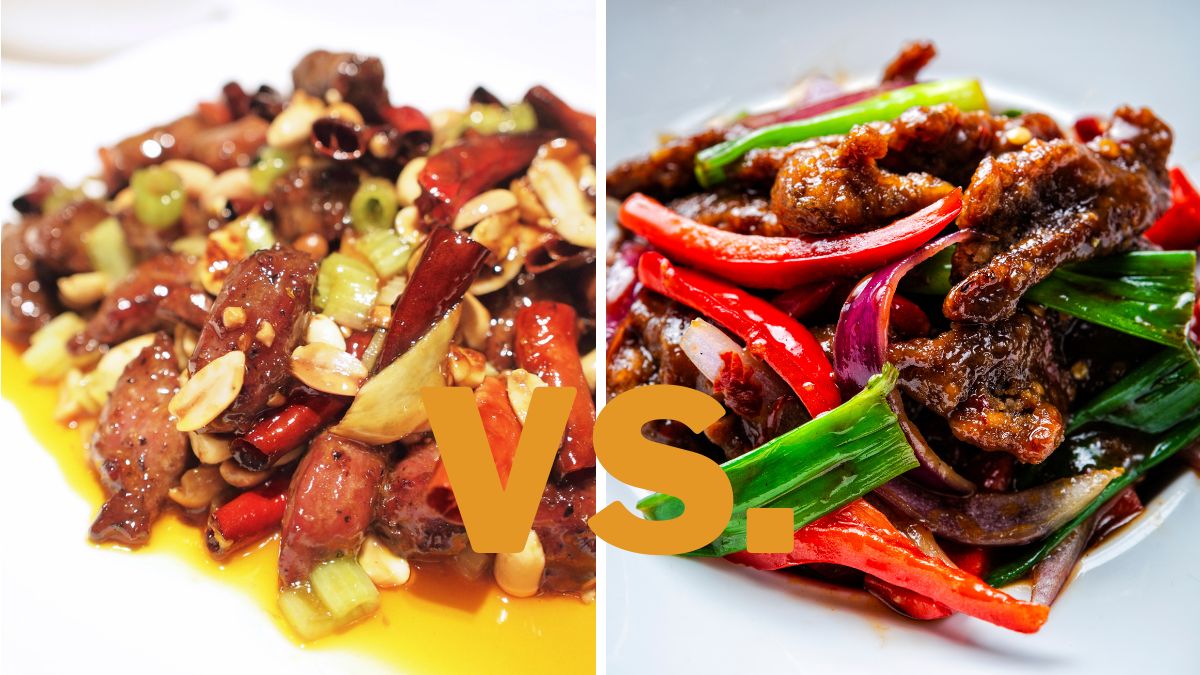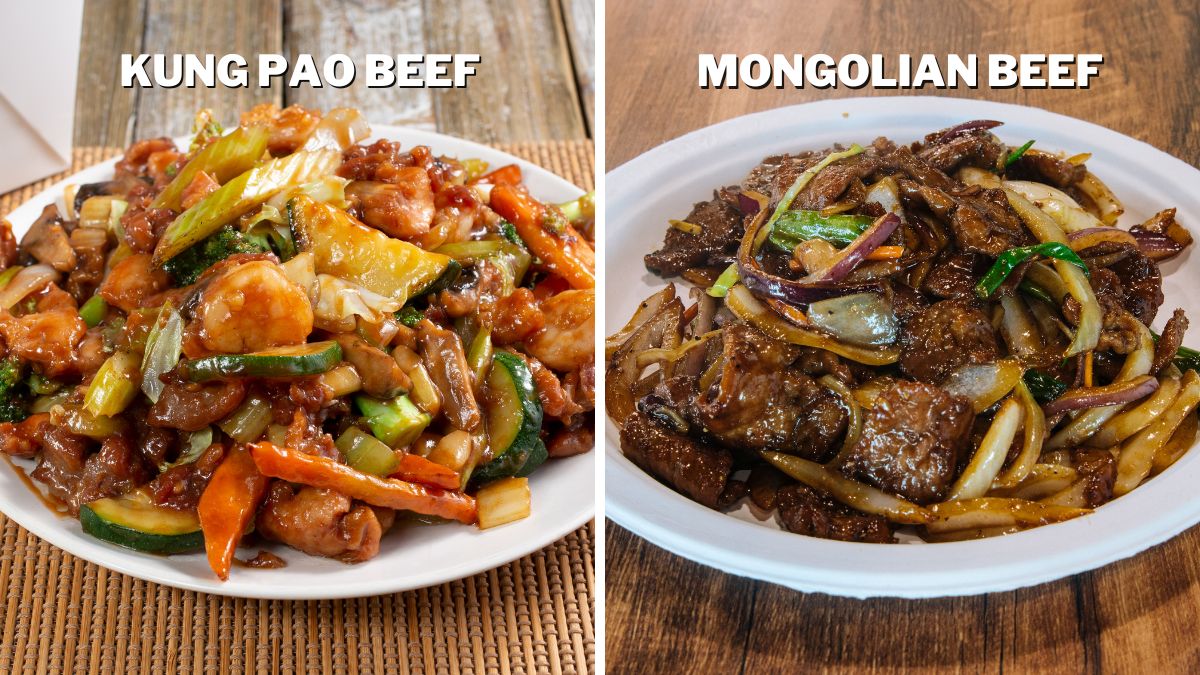Kung Pao Beef vs. Mongolian Beef: Differences & Which Is Better?

As someone who loves Chinese-American cuisine, I can say that Kung Pao and Mongolian beef are two of my favorite dishes. Both are made with tender beef cooked in a delicious sauce and usually served over steamed rice. They each have their own magic, and they are two original dishes. Often mistaken for one for the other, I decided to clear out the air and explain the differences between these delicacies.
Kung Pao and Mongolian beef differ in ingredients, appearance, and taste. Both are Chinese-American dishes served over rice, but Kung Pao has a spicy and slightly sweet sauce with peanuts and chili peppers, while Mongolian has a mellower flavor with green onions and a soy sauce marinade. Both dishes have variations.
These two dishes are so special and original that each of them deserves a moment in the spotlight. In this article, I will explain the differences between Kung Pao and Mongolian beef to help you with your decision the next time you decide to treat yourself to a little Chinese-American delicacy.
Origin
Kung Pao beef originates in Szechuan cuisine, known for its bold and spicy flavors. The dish is named after Ding Baozhen, a Qing Dynasty official who was known as “Kung Pao.” As the legend says, Ding Baozhen was crazy about spicy food and liked his dishes with extra chili peppers.
The original Kung Pao dish was chicken, but it was later transformed into Kung Pao beef. The authentic flavor of this dish is mercilessly spicy and hot, but with the emergence of Chinese restaurants in the US, the cooks adapted the recipe to match the American palate.
The main thing about the origin of Mongolian beef is that it isn’t a Mongolian dish. Its history remains somewhat blurry, but it is believed that it was created by Chinese immigrants in the US. Also, not only is Mongolian beef not Mongolian, but it also doesn’t contain any ingredients from traditional Mongolian cuisine.
It is also well-adapted to American taste, which is why it is so popular in the US.
Appearance and Taste
Kung Pao beef is one of my favorite Chinese-American dishes, and it’s something that I often make and order. The dish is made with sliced or diced beef stir-fried with peanuts, bell peppers, scallions, and chili peppers.
Before stir-frying, you should coat the beef with cornstarch, Shaoxing wine, oil, oyster sauce, and baking soda. Marinade it in this mixture for about an hour and then cook it. The marinate tenderizes the beef and is a very important step as it profoundly impacts the flavor and texture of the meat.
The stir-frying sauce is savory and a bit sweet, with just a tad of spice from the Sichuan peppercorns and chili flakes. The beef is tender and juicy, while the peanuts add a nice crunch. This combination of textures and flavors is what makes Kung Pao beef so appealing.
The bell peppers and scallions give it a fresh and crispy dimension, while the sauce bonds everything together, balancing and rounding up the flavors. The dish usually comes on a bed of rice which absorbs the juices making this delicacy even richer.
Mongolian beef is another one of my favorites. It is different from Kung Pao beef and offers a different experience, but it is still impressive. The beef in Mongolian beef is usually thinly sliced and marinated in a mixture of soy sauce, sugar, and spices such as garlic and ginger. It usually comes with green onions and sometimes chili peppers as well, but the chili peppers aren’t a standard part.
You will definitely love how tender it is. To top it all off, it also bursts with flavors and juices, with a slightly sweet essence to milden up the intense savory notes. Compared to Kung Pao beef, Mongolian beef isn’t as spicy, which is to be expected since it originated in the US. Instead, it has a delightful balance of flavors, making it a great option if you like your food more on the milder side.
Serving Style

The serving style is where Mongolian and Kung Pao beef overlap. They are both served with steamed rice, but they may also be enjoyed with noodles or veggies instead or on their own. Some variations of Kung Pao beef come with sesame seeds and chopped spring onion sprinkled on top, which is how I prefer it.
The sesame seeds give the dish a very nice crunch making it even more pleasant to the palate. On the other hand, the spring onion gives it a freshness, and makes the overall taste richer and fuller.
Popularity and Variations
When speaking about popularity, both Kung Pao beef and Mongolian beef have very rich fan bases. They are both popular Chinese-American dishes and are standard menu items at nearly all Chinese restaurants in the United States. Moreover, they are relatively easy to make, so they are frequent household dishes as well, as is the case with my kitchen.
The cooking methods for both dishes allow for variations and substitutions, so you may find a different version of the same dish depending on where you have it. As long as you don’t skip the marinade, you can play with the other ingredients in both dishes.
For example, some restaurants may make their Kung Pao beef with additional veggies, including zucchini or carrots. Others may use different types of peppers or spices to adjust the level of spiciness. Also, some restaurants often use different types of sauces or marinades for their Mongolian beef to give it a signature taste specific to the restaurant.
Similarities with Other Dishes
As meaty stir-fried dishes, Kung Pao beef and Mongolian beef are similar to other Chinese stir-fry dishes, such as beef with broccoli or beef and snow peas. Also, the marinades they use are frequent sauces in other Chinese dishes that include meat.
These dishes typically feature stir-fried tender beef with vegetables and a juicy and delicious sauce and are commonly served over rice or noodles.
Still, Kung Pao and Mongolian beef have unique flavors, and as similar as they may be to other dishes, they are original in their own right. You can easily set them apart from other stir-fry dishes, even if you have had them only once or twice.
Which Is Better, Kung Pao Beef or Mongolian Beef?
This is a hard, if not impossible, question. Kung Pao beef and Mongolian beef are both excellent dishes and to say that one is better is an unjustifiable insult to the other. Which one you have depends on your personal preference.
If you like more intense flavors and don’t mind dishes having explicit spiciness, you should go for Kung Pao beef. On the other hand, if you like gentler flavors, your choice should be Mongolian beef.
I like edgier flavors, but I enjoy both Kung Pao and Mongolian beef. I would say that people who like spicy food like both dishes, while those with a more refined palate would probably go for Mongolian beef. Still, I suggest you give both a try.
